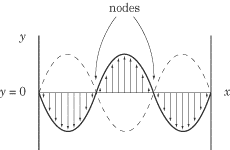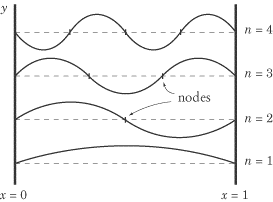Reflection
If a stretched string is tied to a pole at one end, waves traveling down the
string will reflect from the pole and travel back toward their source. A
reflected wave is the mirror image of its original—a pulse in the upward
direction will reflect back in the downward direction—and it will interfere with
any waves it encounters on its way back to the source. In particular, if one end
of a stretched string is forced to oscillate—by tying it to a mass on a spring,
for example—while the other end is tied to a pole, the waves traveling toward
the pole will continuously interfere with their reflected copies. If the length
of the string is a multiple of one-half of the wavelength,
?/2,
then the superposition of the two waves will result in a standing wave that
appears to be still.
v>

Nodes
The crests and troughs of a standing wave do not travel, or propagate, down the
string. Instead, a standing wave has certain points, called nodes, that
remain fixed at the equilibrium position. These are points where the original
wave undergoes complete destructive interference with its reflection. In between
the nodes, the points that oscillate with the greatest amplitude—where the
interference is completely constructive—are called antinodes. The
distance between successive nodes or antinodes is one-half of the wavelength,
?/2.
Resonance and Harmonic Series
The strings on musical instruments vibrate as standing waves. A string is tied
down at both ends, so it can only support standing waves that have nodes at both
ends, and thus can only vibrate at certain given frequencies. The longest such
wave, called the fundamental, or resonance, has two nodes at the
ends and one antinode at the center. Since the two nodes are separated by the
length of the string, L, we see that
the fundamental wavelength is
?l = 2L.
The string can also support standing waves with one, two, three, or any integral
number of nodes in between the two ends. This series of standing waves is called
the harmonic series for the string, and the wavelengths in the series
satisfy the equation
L = n(?/2),
or:
?n = 2L/n

In the figure above, the fundamental is at the bottom, the first member of the
harmonic series, with n =
1. Each successive member has one more node
and a correspondingly shorter wavelength.
Example

An empty bottle of height 0.2 m and a second empty bottle of height 0.4 m are
placed next to each other. One person blows into the tall bottle and one blows
into the shorter bottle. What is the difference in the pitch of the two sounds?
What could you do to make them sound at the same pitch?
Sound comes out of bottles when you blow on them because your breath creates a
series of standing waves inside the bottle. The pitch of the sound is inversely
proportional to the wavelength, according to the equation
v = ƒ?
.
We know that the wavelength is directly proportional to the length of the
standing wave: the longer the standing wave, the greater the wavelength and the
lower the frequency. The tall bottle is twice as long as the short bottle, so it
vibrates at twice the wavelength and one-half the frequency of the shorter
bottle. To make both bottles sound at the same pitch, you would have to alter
the wavelength inside the bottles to produce the same frequency. If the tall
bottle were half-filled with water, the wavelength of the standing wave would
decrease to the same as the small bottle, producing the same pitch.
Pitch of Stringed Instruments
When violinists draw their bows across a string, they do not force the string to
oscillate at any particular frequency, the way the mass on a spring does. The
friction between the bow and the string simply draws the string out of its
equilibrium position, and this causes standing waves at all the different
wavelengths in the harmonic series. To determine what pitches a violin string of
a given length can produce, we must find the frequencies corresponding to these
standing waves. Recalling the two equations we know for the wave speed,
 and
v = ƒ?,
we can solve for the frequency,
ƒn,
for any term, n, in the harmonic
series. A higher frequency means a higher pitch.
and
v = ƒ?,
we can solve for the frequency,
ƒn,
for any term, n, in the harmonic
series. A higher frequency means a higher pitch.

You won’t need to memorize this equation, but you should understand the gist of
it. This equation tells you that a higher frequency is produced by (1) a taut
string, (2) a string with low mass density, and (3) a string with a short
wavelength. Anyone who plays a stringed instrument knows this instinctively. If
you tighten a string, the pitch goes up (1); the strings that play higher
pitches are much thinner than the fat strings for low notes (2); and by placing
your finger on a string somewhere along the neck of the instrument, you shorten
the wavelength and raise the pitch (3).
Back
Next
Next to display next topic in the chapter.
Practice Questions
Video Lessons and 10 Fully Explained Grand Tests
Large number of solved practice MCQ with explanations. Video Lessons and 10 Fully explained Grand/Full Tests.